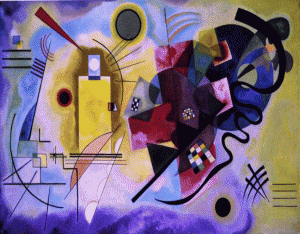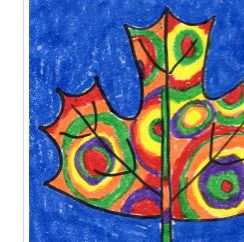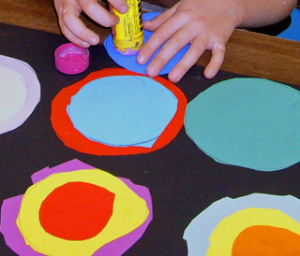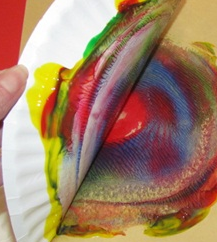
Wassily Kandinsky was a very well known abstract artist. His paintings were not geared towards children yet Kandinsky for kids is something that many art teachers are looking for to see how they can use the works of this well know artist to enhance the children’s appreciation for good, abstract art.
Many of the great artists works don’t lend themselves to children.They are often very detailed and extremely representational and they make children feel like they can never be like them. Abstract artists on the other hand are more up children’s alley as they used techniques that children themselves can try to emulate. Though they were usually accomplished realists their work is not threatening to children.
Kandinsky did not even start out as an artist. He actually was a lawyer and first and did not begin studying art until he was about 30years old. (Proof that you CAN teach old dogs new tricks.) Kandinsky started painting after the era of the impressionists and was the first artist to actually move away from any form of realism in his pictures.
Kandinsky used gorgeous colors and he painted pure design, concentrating on color and design.(like the image below)

He felt the colors and design had meaning in themselves which is a very important concept in introducing Kandinsky for children.
This post is not one meant to teach you all about Kandinsky as you can find out that stuff on other websites. It is meant to introduce abstract art to kids and to have them try out activities to be a bit like Kandinsky himself.
I am going to give you a simple lesson plan for teaching Kandinsky to kids and then give you some examples that other educators have done with the Kandinsky circles.
Kandinsky lesson plan
- Start by gathering as many samples as you can of Kandinskys paintings. When children view a group of images that are the work of one artist, it puts them in the mood of that artist. They can in essence become Kandinsky kids
- Have the children tell you what they notice about each of his paintings. When I teach teachers to notice and comment on their childrens art I have them look at shape, color, size placement and anything else they SEE in the picture. Children can be trained to see beyond the representational by just noticing what’s there.
- You can play a game with the children where you copy different parts of a painting, show them in card form to the children and have them find that part of the painting on the real painting.
- Another idea is to copy over one of his paintings, put it on cardboard, cut it up into a puzzle and have the children piece it together following the original picture of it.
- Start off the painting activities by having the children paint with one color using different parts of their arms. Use the brush from the shoulder, then only moving the elbow, then the writs and then only the fingers. You can discuss with the children how you can make different shapes and patterns depending on how and which part of the arm and hand you use to paint. Sweeping arcs are certainly done in a different way then small marks.
- Then give the children some bright colors and have them paint again moving different parts of their arm but, this time concentrating on the designs they are creating to see the different marks they make. Have them hold on to their shoulders and try to paint from the shoulder. They will be holding on to their shoulder with their other arm so that they can feel where the movement is coming from. Then do the same with their elbows, wrist and fingers.
Kandinsky was a musician as well as an artist and thought of complex paintings as symphonies. As a result of that, many teachers who are incorporating Kandinsky lesson plans into their curriculum will start with an art activity that is related to music.
- Put on different kinds of music and have the children listen to each piece of music and paint to the music itself using bright watercolors, or bright tempera. Tell them to move according to the tempo of the music. First let them lie quietly and listen to it without moving. Then play it a second time. The third time give the children paintbrushes and paint and let them paint to the music If you pick a piece of music that has different sounds in it tell them that they can use the different parts of their arms and hands according to the music. Make sure it is not a long piece as the children will have no patience to listen to anything too long.
- After the children are done you should discuss with them how the music made them feel and how that translated into the movements they made on their papers.
Concentric circles by Kandinsky

Squares and Concentric Circles is one of Kandinsky’s most recognizable works as a result it is the piece of work that most teachers tend to try to emulate.
I happen to love Kandinsky because aside from the fact that I love his colors and designs, for children it is great as his work is in museums, sells for high prices and yet any child can feel that they could easily do what he does. How you incorporate Kandinsky for children really depends on how deep you want to go with this.
If the children are older you may want to include in the Kandinsky lesson plan more about this life and go deeper into the different paintings of his. I find that most teachers are usually touching upon each artist individually and not so much in depth. Therefore, Kandinsky art for kids will only be one of many artists that they are learning about. The kindergarten and preschool age children need to know very little about the artist, the name of the artist types of paintings he or she did and plenty of actual painting experiences are what they need. Elementary school age children can deal with more info.
5 more Kandinsky art projects
The first one here is from art projects for kids. You take a leaf template, make a leaf and have them color it using all circles.
The next one is from one of my favorite art ed sites deep space sparkle. Here she used paper circles and glue to construct Kandinsky circles.
The next is from a well know preschool blog called teach preschool.
She used paper plates and paint to create the circles by smushing the paint on the plate.
The next is from a facebook page and uses a few different sized round objects to create the effect.
This last one is similar to the collage one but, uses foam pieces instead and I don’t have the website it was from.

I’m sure you can use other parts of Kandinskys work in your art projects but, the circles are so easy and so much fun so its a great place to start.
Pin to save for later









Hello.
I thought I saw an art lesson using Kandinsky’s art this weekend. It was a winter landscape with snow and a fence. Does this sound at all familiar to you? I am an elementary school teacher and would love to use the lesson with my kids.
Thanks.
Hi Diana,
I dont think you saw it at this blog but I do have a great idea for you if you want to do a winter landscape with snow and a fence. I’m not sure what kind of materials you have available but this can be a multi media art project. If you give the children black construction paper and let them paint snow with white paint all over. After its dry you can give them all sorts of materials that add to it to make fences, trees, etc. You can give them crafts sticks, cut up pieces of other colored construction paper etc.
You can take a look at this post that I did a fall crafts in a similar manner.
Good luck finding what you need if this doesn’t work for you
Love this site! I teach Montessori and needed some ideas for summer camp at our school. We used colored card stock paper and made the Kandinsky Tree. The kids loved it!! Great ideas 🙂
I loved this blog. It gave me some great ideas for teaching Kandinsky and made me realise I need to get on with the art and not focus on the facts – as you say, they can do that on the internet! Will try out the activities with my year 5 and 6 children.
Many thanks
Yvonne.